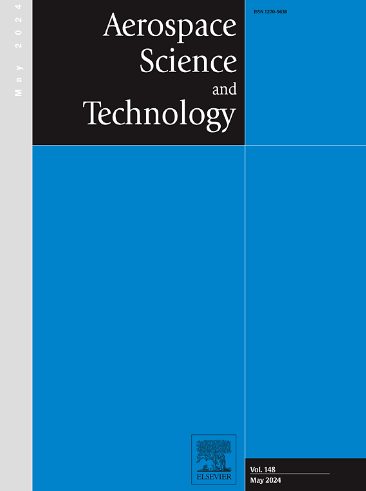Effects of the rotor tip gap on the aerodynamic and aeroacoustic performance of a ducted rotor in hover
IF 5
1区 工程技术
Q1 ENGINEERING, AEROSPACE
引用次数: 0
Abstract
Ducted rotors are configurations known to outperform their unducted reference baselines when aerodynamic performance is concerned. Aside from aerodynamic benefits in hover, a duct also affects acoustic emissions. One of the most contended design parameters of a duct-rotor assembly is the radial distance between the blade tip and the duct wall, referred to as the “tip gap”. The present study explains how the aerodynamic performance of a ducted-rotor system is affected by the tip-gap distance, taking into account the performance of the rotor and those of the duct's inlet lip and diffuser sections. Separate thrust measurements of the rotor and duct establish that the latter can generate up to half of the total thrust of the assembly. Static wall-pressure measurements along the inner wall of the duct reveal a low pressure suction zone over the duct's inlet lip area. This allows the assembly to generate more thrust than the rotor alone, even though the duct's diffuser section generates a drag component (negative thrust). From the velocity fields it is further shown that the performance-deterioration with an increasing tip gap distance is associated with a contraction of the rotor slipstream in the duct diffuser.
转子顶端间隙对悬停中管道式转子气动和气声性能的影响
众所周知,在气动性能方面,有风道转子的配置优于无风道参考基线。除了悬停时的气动优势外,风道还会影响声发射。风道旋翼组件最受争议的设计参数之一是叶尖与风道壁之间的径向距离,称为 "叶尖间隙"。本研究解释了风道转子系统的气动性能如何受到叶尖间隙距离的影响,同时考虑了转子的性能以及风道入口唇和扩散器部分的性能。对转子和导管分别进行的推力测量结果表明,后者产生的推力最多可达组件总推力的一半。沿风道内壁进行的静态壁压测量显示,在风道的入口边缘区域有一个低压吸入区。这使得组件产生的推力大于转子单独产生的推力,即使风道的扩散器部分会产生阻力分量(负推力)。速度场进一步表明,随着顶端间隙距离的增加,性能下降与转子滑流在管道扩散器中的收缩有关。
本文章由计算机程序翻译,如有差异,请以英文原文为准。
求助全文
约1分钟内获得全文
求助全文
来源期刊

Aerospace Science and Technology
工程技术-工程:宇航
CiteScore
10.30
自引率
28.60%
发文量
654
审稿时长
54 days
期刊介绍:
Aerospace Science and Technology publishes articles of outstanding scientific quality. Each article is reviewed by two referees. The journal welcomes papers from a wide range of countries. This journal publishes original papers, review articles and short communications related to all fields of aerospace research, fundamental and applied, potential applications of which are clearly related to:
• The design and the manufacture of aircraft, helicopters, missiles, launchers and satellites
• The control of their environment
• The study of various systems they are involved in, as supports or as targets.
Authors are invited to submit papers on new advances in the following topics to aerospace applications:
• Fluid dynamics
• Energetics and propulsion
• Materials and structures
• Flight mechanics
• Navigation, guidance and control
• Acoustics
• Optics
• Electromagnetism and radar
• Signal and image processing
• Information processing
• Data fusion
• Decision aid
• Human behaviour
• Robotics and intelligent systems
• Complex system engineering.
Etc.
 求助内容:
求助内容: 应助结果提醒方式:
应助结果提醒方式:


